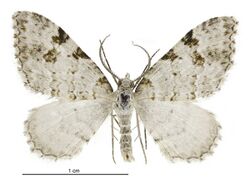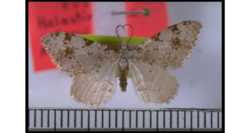Biology:Helastia alba
| Helastia alba | |
|---|---|

| |
| Male | |
| Scientific classification | |
| Domain: | Eukaryota |
| Kingdom: | Animalia |
| Phylum: | Arthropoda |
| Class: | Insecta |
| Order: | Lepidoptera |
| Family: | Geometridae |
| Genus: | Helastia |
| Species: | H. alba
|
| Binomial name | |
| Helastia alba Craw, 1987[1]
| |
Helastia alba is a moth of the family Geometridae.[1] This species is endemic to New Zealand and is found only in the South Island. This species inhabits native forest or scrubland and can be observed in montane to subalpine Nothofagus dominant forests. It has also been observed at lower altitudes in native podocarp forests. Larvae of this species have been raised on mosses. Adults are on the wing from November to January and are nocturnal. This species is very similar in appearance to other species in the genus Helastia, but specimens can be distinguished by the dissection of their genitalia.
Taxonomy
This species was first described by Robin C. Craw in 1987.[2] The male holotype, collected by Merlin Owen Pascoe in Queenstown, is held in the New Zealand Arthropod Collection.[3]
Description
Craw described this species as follows:
Small to medium sized (r.f.l. 9-12.5mm) triangular forewing. Upper side forewing coloration and pattern dull whitish to whitish grey with dark brown to brown-ish ochreous wavy transverse lines. Male antennae bipectinated.[2]
Distribution
This species is endemic to New Zealand.[4][5] This species is found only in the South Island and has been observed in the following regions: Nelson, Buller, North Canterbury, Mid Canterbury, Mackenzie, Otago Lakes, Fiordland and Southland.[2] In the Otago Lakes region it is regarded as being widespread but local in occurrence.[6]
Species within the genus Helastia are very similar in appearance and as such can be difficult to identify.[7] H. alba has frequently been confused with H. cinerearia or with H. mutabilis.[2] However all these species can be distinguished from one another by the dissection of the genitalia of the specimen.[2]
Habitat and hosts
This species inhabits the edge of native forest or shrubland.[6] It lives in Nothofagus forests at altitudes ranging from montane to sub-alpine.[2] It has also been observed in native podocarp forests at lower altitudes.[2] Larvae have been raised on mosses.[7]
Behaviour
Adults are on the wing from November to January.[8] They are nocturnal and are attracted to light.[2]
References
| Wikimedia Commons has media related to Helastia alba. |
- ↑ 1.0 1.1 "Helastia alba Craw, 1987 - Biota of NZ". https://biotanz.landcareresearch.co.nz/scientific-names/94af2ceb-874b-4639-9cc0-3a5ba049b9d8.
- ↑ 2.0 2.1 2.2 2.3 2.4 2.5 2.6 2.7 , Wikidata Q54670161
- ↑ , pp. 180, Wikidata Q45083134
- ↑ , pp. 459, Wikidata Q45922947
- ↑ "Helastia alba Craw, 1987". https://www.nzor.org.nz/names/b0b0d472-de41-44ea-bbfb-46f220303807.
- ↑ 6.0 6.1 Crown Pastoral Land Tenure Review Castle Dent Conservation Resources Report - Part 1 (Report). Land Information New Zealand. August 2005. https://www.linz.govt.nz/sites/default/files/cp/castle-dent-crr-pt1.pdf.
- ↑ 7.0 7.1 , pp. 96, Wikidata Q59396160
- ↑ "Helastia alba" (in en). https://www.inaturalist.org/taxa/390319-Helastia-alba.
Wikidata ☰ Q10519436 entry
 |


